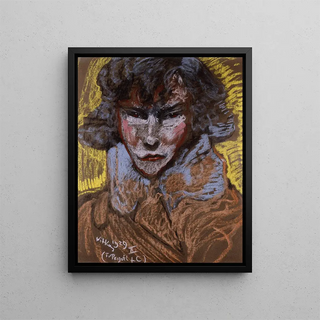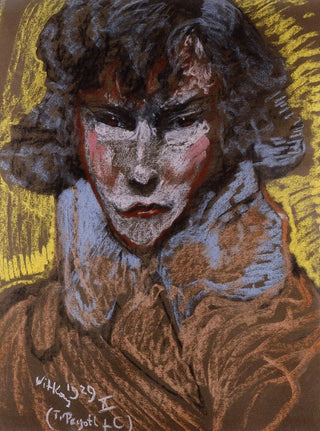Art print | Portrait of Halina Byczyńska - Stanisław Ignacy Witkiewicz


View from behind

Frame (optional)
Reproduction Portrait of Halina Byczyńska - Stanisław Ignacy Witkiewicz – Captivating introduction
The "Portrait of Halina Byczyńska" by Stanisław Ignacy Witkiewicz is a work that transcends the simple frame of painting to immerse the viewer in a universe rich in emotions and reflections. Created in the 1910s, this portrait does not merely depict a human figure but evokes psychological depth and aesthetic complexity that captivate the eye and mind. Halina Byczyńska, model and muse, is immortalized here with an intensity that seems to defy the passage of time. Through this work, Witkiewicz invites us to explore the subtleties of the human soul while immersing us in the cultural and artistic context of his era.
Style and uniqueness of the work
Witkiewicz's style is distinguished by a bold and innovative approach, blending influences of post-impressionism and symbolism. In this portrait, vibrant colors and expressive brushstrokes create an atmosphere that is both intimate and unsettling. The composition, centered on Halina's face, highlights the details of her expression, revealing a rich emotional palette. Shades of blue and red, carefully chosen, evoke feelings of melancholy and passion, while the blurred background seems to fade to better highlight the human figure. This stylistic choice reflects a desire to capture not only the external appearance but also the very essence of the person depicted—a challenge that Witkiewicz meets with brilliance.
The artist and his influence
Stanisław Ignacy Witkiewicz, often known as Witkacy, is a prominent figure in 20th-century Polish art. His work is marked by an unceasing quest for identity and inner truth, influenced by his philosophical and psychological reflections. Witkiewicz was also a playwright and writer, which allowed him to explore complex themes through various mediums. His avant-garde approach and unique style had a significant impact on the Polish artistic scene and beyond. By integrating elements of psychology and spirituality into his

Matte finish

View from behind

Frame (optional)
Reproduction Portrait of Halina Byczyńska - Stanisław Ignacy Witkiewicz – Captivating introduction
The "Portrait of Halina Byczyńska" by Stanisław Ignacy Witkiewicz is a work that transcends the simple frame of painting to immerse the viewer in a universe rich in emotions and reflections. Created in the 1910s, this portrait does not merely depict a human figure but evokes psychological depth and aesthetic complexity that captivate the eye and mind. Halina Byczyńska, model and muse, is immortalized here with an intensity that seems to defy the passage of time. Through this work, Witkiewicz invites us to explore the subtleties of the human soul while immersing us in the cultural and artistic context of his era.
Style and uniqueness of the work
Witkiewicz's style is distinguished by a bold and innovative approach, blending influences of post-impressionism and symbolism. In this portrait, vibrant colors and expressive brushstrokes create an atmosphere that is both intimate and unsettling. The composition, centered on Halina's face, highlights the details of her expression, revealing a rich emotional palette. Shades of blue and red, carefully chosen, evoke feelings of melancholy and passion, while the blurred background seems to fade to better highlight the human figure. This stylistic choice reflects a desire to capture not only the external appearance but also the very essence of the person depicted—a challenge that Witkiewicz meets with brilliance.
The artist and his influence
Stanisław Ignacy Witkiewicz, often known as Witkacy, is a prominent figure in 20th-century Polish art. His work is marked by an unceasing quest for identity and inner truth, influenced by his philosophical and psychological reflections. Witkiewicz was also a playwright and writer, which allowed him to explore complex themes through various mediums. His avant-garde approach and unique style had a significant impact on the Polish artistic scene and beyond. By integrating elements of psychology and spirituality into his






